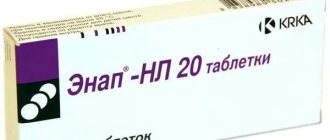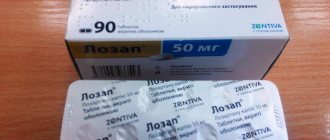Candesartan
Renal dysfunction
During therapy with Candesartan, as with the use of other drugs that affect or act on the renin-angiotensin-aldosterone system, some patients may experience impaired renal function.
When using the drug Candesartan in patients with arterial hypertension and severe renal impairment (creatinine clearance less than 30 ml/min), it is recommended to periodically monitor the potassium content and creatinine concentration in the blood serum. Clinical experience with the drug in patients with severe renal impairment or end-stage renal failure (creatinine clearance less than 15 ml/min) is limited. Such patients should carefully adjust the dose of Candesartan under close monitoring of blood pressure.
In patients with chronic heart failure, renal function should be periodically monitored, especially in patients aged 75 years and older, as well as in patients with impaired renal function.
When increasing the dose of Candesartan, it is also recommended to monitor potassium levels and creatinine concentrations.
Clinical studies of candesartan in chronic heart failure did not include patients with creatinine concentrations > 265 μmol/L (> 3 mg/dL).
Combined use with ACE inhibitors in chronic heart failure
When using candesartan in combination with ACE inhibitors, the risk of side effects may increase, especially renal dysfunction and hyperkalemia (see section "Side effects"). In these cases, careful observation and monitoring of laboratory parameters is necessary.
Hemodialysis
During hemodialysis, blood pressure may respond particularly sensitively to AT1 receptor blockade due to decreased plasma volume and activation of the renin-angiotensin-aldosterone system. Therefore, patients on hemodialysis should be carefully titrated with Candesartan under close blood pressure monitoring.
Renal artery stenosis
In patients with bilateral renal artery stenosis or stenosis of the artery of a solitary kidney, drugs that affect the renin-angiotensin-aldosterone system, in particular ACE inhibitors, may cause an increase in serum urea and creatinine concentrations. Similar effects can be expected with the use of angiotensin II receptor antagonists.
Kidney transplant
Clinical experience with the use of candesartan in patients who have undergone kidney transplantation is limited.
Arterial hypotension
In patients with chronic heart failure during therapy with Candesartan, arterial hypotension may develop. As with other drugs that affect the renin-angiotensin-aldosterone system, the development of arterial hypotension in patients with arterial hypertension may be due to a decrease in circulating blood volume, as observed in patients receiving high doses of diuretics. Therefore, at the beginning of therapy, caution should be exercised and, if necessary, correction of hypovolemia should be carried out.
Dual blockade of the renin-angiotensin-aldosterone system
Dual blockade of the renin-angiotensin-aldosterone system by combining candesartan cilexetil and aliskiren is not recommended due to the increased risk of arterial hypotension, hyperkalemia and changes in renal function.
The use of candesartan cilexetil in combination with aliskiren is contraindicated in patients with diabetes mellitus and/or with moderate or severe renal impairment (glomerular filtration rate less than 60 ml/min/1.73 m2 body surface area) and is not recommended in other patients.
Concomitant use of angiotensin II receptor antagonists with ACE inhibitors is contraindicated in patients with diabetic nephropathy and is not recommended in other patients (see section "Contraindications").
General anesthesia and surgery
In patients receiving angiotensin II receptor antagonists, hypotension may develop during general anesthesia and during surgery as a result of blockade of the renin-angiotensin-aldosterone system. Very rarely, cases of severe arterial hypotension may occur, requiring intravenous administration of plasma replacement solutions and/or vasopressors.
Aortic and mitral valve stenosis or hypertrophic obstructive cardiomyopathy
When prescribing Candesartan, like other vasodilators, patients with hypertrophic obstructive cardiomyopathy or hemodynamically significant stenosis of the aortic or mitral valves should be careful.
Primary hyperaldosteronism
Patients with primary hyperaldosteronism are usually resistant to treatment with antihypertensive drugs that affect the renin-angiotensin-aldosterone system. In this regard, Candesartan is not recommended for use in such patients.
Hyperkalemia
Clinical experience with other drugs that affect the renin-angiotensin-aldosterone system shows that the simultaneous administration of candesartan with potassium-sparing diuretics, potassium supplements or salt substitutes containing potassium, or other drugs that can increase potassium levels in the blood (for example, heparin) , may lead to the development of hyperkalemia in patients with arterial hypertension.
In patients with chronic heart failure during therapy with candesartan, hyperkalemia may develop. When prescribing Candesartan to patients with chronic heart failure, regular monitoring of potassium levels in the blood is recommended, especially when co-administered with ACE inhibitors and potassium-sparing diuretics.
Are common
Patients whose vascular tone and nocturnal function are primarily dependent on the activity of the renin-angiotensin-aldosterone system (for example, patients with severe chronic heart failure or kidney disease, including renal artery stenosis) are especially sensitive to drugs that act on the renin-angiotensin-aldosterone system. system. The prescription of such drugs is accompanied in these patients by severe arterial hypotension, azotemia, oliguria and, less commonly, acute renal failure.
The possibility of developing the listed effects cannot be excluded when using angiotensin II receptor antagonists.
A sharp decrease in blood pressure in patients with coronary heart disease or cerebrovascular diseases of atherosclerotic origin, when using any antihypertensive drugs, can lead to the development of myocardial infarction or stroke.
Atacand TB 32 mg N 28
Description:
ATX Code:
C09CA06 (Candesartan)
Active substance:
candesartan
Dosage form
| ATACAND® | tab. 32 mg: 28 pcs. reg. No.: LSR-001353/08 dated 02.29.08 - Indefinitely |
Release form, composition and packaging
The tablets are pink, round, biconvex, scored and engraved with the letters “A” over “CL” on one side and “032” on the other.
| 1 tab. | |
| candesartan cilexetil | 32 mg |
Excipients: calcium carboxymethylcellulose (carmellose calcium salt) - 11 mg, hyprolose - 8 mg, red iron oxide dye (E172) - 0.52 mg, lactose monohydrate - 163 mg, magnesium stearate - 0.8 mg, corn starch - 40 mg, macrogol - 5.2 mg.
14 pcs. - PVC/aluminum blisters (2) - cardboard packs.
Clinical and pharmacological group:
Angiotensin II receptor antagonist
Pharmacotherapeutic group:
Angiotensin II receptor antagonist
pharmachologic effect
Antihypertensive drug, angiotensin II receptor antagonist, selectively acting on AT1 receptors. Angiotensin II is the main hormone of the RAAS, which plays an important role in the pathogenesis of arterial hypertension, heart failure and other cardiovascular diseases. The main physiological effects of angiotensin II are vasoconstriction, stimulation of aldosterone production, regulation of water-electrolyte homeostasis and stimulation of cell growth. All these effects are mediated by the interaction of angiotensin II with angiotensin type 1 receptors (AT1 receptors).
Candesartan does not inhibit ACE, which converts angiotensin I to angiotensin II and destroys bradykinin; does not affect ACE and does not lead to the accumulation of bradykinin or substance P. When comparing candesartan with ACE inhibitors, the development of cough was less common in patients receiving candesartan cilexetil. Candesartan does not bind to the receptors of other hormones and does not block ion channels involved in the regulation of the functions of the cardiovascular system. As a result of blocking the AT1 receptors of angiotensin II, there is a dose-dependent increase in renin activity, the concentration of angiotensin I, angiotensin II and a decrease in the concentration of aldosterone in the blood plasma.
Arterial hypertension
In arterial hypertension, candesartan causes a dose-dependent long-term decrease in blood pressure. The antihypertensive effect of the drug is due to a decrease in peripheral vascular resistance, without changing heart rate. There were no cases of severe arterial hypotension after taking the first dose of the drug, as well as no effect after cessation of therapy.
The onset of the hypotensive effect after taking the first dose of candesartan cilexetil usually develops within 2 hours. With continued therapy with the drug at a fixed dose, the maximum reduction in blood pressure is usually achieved within 4 weeks and is maintained throughout treatment. Candesartan cilexetil, prescribed once a day, provides an effective and smooth decrease in blood pressure over 24 hours with minor fluctuations in blood pressure in the intervals between doses of the drug. The use of candesartan cilexetil in combination with hydrochlorothiazide leads to an increased hypotensive effect. The combined use of candesartan cilexetil and hydrochlorothiazide (or amlodipine) is well tolerated.
The effectiveness of the drug does not depend on the age and gender of patients.
Candesartan cilexetil increases renal blood flow and does not change or increases glomerular filtration rate, while renal vascular resistance and filtration fraction are reduced. Taking candesartan cilexetil at a dose of 8-16 mg for 12 weeks does not have a negative effect on glucose levels and lipid profiles in patients with arterial hypertension and type 2 diabetes mellitus.
The clinical effect of candesartan cilexetil on morbidity and mortality when taken at a dose of 8-16 mg (mean dose 12 mg) 1 time / day was studied in a randomized clinical trial involving 4937 elderly patients (age from 70 to 89 years, 21% of patients in aged 80 years and older) with mild to moderate hypertension receiving candesartan cilexetil therapy for an average of 3.7 years (SCORE study - a study of cognitive function and prognosis in elderly patients). Patients received candesartan or placebo, if necessary, in combination with other antihypertensive drugs. Both treatment regimens showed an effective reduction in systolic and diastolic blood pressure (from 166/90 to 145/80 mmHg in the group of patients receiving candesartan, and from 167/90 to 149/82 mmHg in the control group) by background of good tolerability. Cognitive function and quality of life remained at a good level in both groups of patients. There were no statistically significant differences in the incidence of cardiovascular complications (cardiovascular mortality, incidence of non-fatal myocardial infarction and non-fatal stroke) between these two groups of patients.
In the group of patients receiving candesartan, there were 26.7 cases of cardiovascular events per 1000 patient-years compared with 30 cases per 1000 patient-years in the control group (relative risk = 0.89, 95% confidence interval 0.75-1.06, p = 0.19).
The table below presents the results of the assessment of the primary endpoint (cardiovascular events) and its components.
| Number of patients with primary event | Relative risk (95% CI) | R | ||
| Candesartan cilexetil* (n=2477) | Control* (n=2460) | |||
| Cardiovascular complications | 242 | 268 | 0.89 (0.75-1.06) | 0.19 |
| - cardiovascular mortality | 145 | 152 | 0.95 (0.75-1.19) | 0.63 |
| - non-fatal stroke | 68 | 93 | 0.72 (0.53-0.99) | 0.04 |
| - non-fatal myocardial infarction | 54 | 47 | 1.14 (0.77-1.68) | 0.52 |
* Before randomization, any previous antihypertensive therapy was standardized to hydrochlorothiazide at a dose of 12.5 mg 1 time / day. Another antihypertensive agent was added to the double-blind study drug (candesartan cilexetil 8–16 mg or placebo once daily) if systolic blood pressure remained ≥160 mmHg. and/or diastolic blood pressure ≥90 mm Hg. 49% and 66% of patients in the candesartan cilexetil group and control group, respectively, received such additional therapy.
Heart failure
According to the results of the CHARM (Candesartan in Heart Failure - Mortality and Morbidity Reduction Assessment) study, the use of candesartan cilexetil led to a reduction in the incidence of death and the need for hospitalization for chronic heart failure and to an improvement in left ventricular systolic function.
Patients with chronic heart failure, in addition to the main therapy, received candesartan cilexetil at a dose of 4-8 mg/day with a dose increase to 32 mg/day or to the maximum tolerated therapeutic dose (the average dose of candesartan was 24 mg). The median follow-up duration was 37.7 months. After 6 months of therapy, 63% of patients continuing to take candesartan cilexetil (89%) received a therapeutic dose of 32 mg.
Another study, CHARM-Alternative (n = 2,028), included patients with reduced left ventricular ejection fraction (LVEF ≤ 40%) who did not receive an ACE inhibitor due to intolerance (mainly due to cough - 72%); The rates of cardiovascular death and first hospitalization for chronic heart failure were significantly lower in the candesartan group compared with the placebo group (hazard ratio = 0.77, 95% confidence interval 0.67-0.89, p < 0.001). The relative risk reduction was 23%. Statistically, in this study, to prevent one cardiovascular death or hospitalization for chronic heart failure, it was necessary to treat 14 patients throughout the study period. The combined criterion, which included the incidence of deaths regardless of their cause and the rate of first hospitalization for chronic heart failure, was also significantly lower in the group of patients receiving candesartan (hazard ratio = 0.80, 95% confidence interval 0.70-0.92, p = 0.001). At the same time, a positive effect of candesartan was noted on each of the components of this combined criterion - the frequency of deaths and morbidity (an indicator of the frequency of hospitalizations for heart failure). The use of candesartan cilexetil led to an improvement in the functional class of chronic heart failure according to the NYHA classification (p = 0.008).
In the CHARM-Added study (n=2548), patients with reduced LVEF (≤ 40%) receiving ACE inhibitors had a significantly lower composite endpoint of cardiovascular mortality and first hospitalization for chronic heart failure. in the group of patients receiving candesartan compared with the placebo group (hazard ratio = 0.85, 95% confidence interval 0.75-0.96, p = 0.011), which corresponded to a 15% reduction in relative risk. In this study, to prevent one cardiovascular death or hospitalization for chronic heart failure, it was necessary to treat 23 patients throughout the study period. The value of the combined efficacy criterion, which included an assessment of the incidence of deaths regardless of their cause or the incidence of first hospitalization for chronic heart failure, was significantly lower in the group of patients receiving candesartan (hazard ratio = 0.87, 95% confidence interval 0.78-0.98, p=0.021), which also indicated a positive effect when using candesartan. The use of candesartan cilexetil led to an improvement in the functional class of chronic heart failure according to the NYHA classification (p = 0.020).
In the CHARM-Preserve study (n = 3023), in patients with LVEF > 40%, there were no statistically significant differences in the value of the combined effectiveness criterion, which included the incidence of death and the incidence of first hospitalization for chronic heart failure, in the candesartan and placebo groups (hazard ratio = 0.89, 95% confidence interval 0.77-1.03, p = 0.118). The small numerical decrease in this criterion was due to a decrease in the frequency of hospitalizations for chronic heart failure. This study did not show the effect of candesartan on the incidence of deaths.
When separately analyzing the results of 3 studies of the CHARM program, there were no significant differences in the incidence of deaths in the candesartan and placebo groups. However, the incidence of death was estimated in the combined population of the CHARM-Alternative and CHARM-Added studies and in all 3 studies (hazard ratio = 0.91, 95% confidence interval 0.83-1.00, p = 0.055). The reduction in the incidence of death and hospitalization for chronic heart failure during therapy with candesartan was independent of age, gender and concomitant therapy. Candesartan was also effective in patients taking beta-blockers in combination with ACE inhibitors, and the effectiveness of candesartan was independent of whether the patient was taking the optimal dose of the ACE inhibitor or not.
In patients with chronic heart failure and LVEF ≤ 40%, taking candesartan contributed to a decrease in peripheral vascular resistance and capillary pressure in the lungs, an increase in renin activity and angiotensin II concentration in plasma, as well as a decrease in aldosterone levels.
Pharmacokinetics
Suction and distribution
Candesartan cilexetil is an oral prodrug. After taking the drug orally, candesartan cilexetil is quickly converted into the active substance candesartan through ether hydrolysis. Strongly binds to AT1 receptors and dissociates slowly, has no agonist properties. The absolute bioavailability of candesartan after oral administration of candesartan cilexetil solution is about 40%. The relative bioavailability of the tablet preparation compared to the oral solution is approximately 34%. Thus, the calculated absolute bioavailability of the tablet form of the drug is 14%.
Cmax is achieved on average 3-4 hours after taking the tablet form of the drug. As the dose of the drug increases within the recommended doses, the concentration of candesartan increases linearly.
The pharmacokinetic parameters of candesartan do not depend on the gender of the patient. Food intake does not have a significant effect on AUC, i.e. food does not significantly affect the bioavailability of the drug.
Candesartan is actively bound to plasma proteins (>99%). Vd of candesartan is 0.1 l/kg.
Metabolism and excretion
Candesartan is mainly excreted unchanged from the body in urine and bile and is only slightly metabolized in the liver. T1/2 of candesartan is approximately 9 hours. Cumulation of the drug in the body is not observed.
The total clearance of candesartan is about 0.37 ml/min/kg, while the renal clearance is about 0.19 ml/min/kg. Renal excretion of candesartan is carried out by glomerular filtration and active tubular secretion. Following oral administration of radiolabeled candesartan cilexetil, approximately 26% of the administered amount is excreted in the urine as candesartan and 7% as an inactive metabolite, whereas 56% of the administered amount is found in the feces as candesartan and 10% as an inactive metabolite.
Pharmacokinetics in special clinical situations
In elderly patients over 65 years of age, the Cmax and AUC of candesartan increase by 50% and 80%, respectively, compared with younger patients. However, the hypotensive effect and the incidence of side effects when using the drug Atacand® do not depend on the age of the patients.
In patients with mild and moderate renal impairment, Cmax and AUC of candesartan increased by 50% and 70%, respectively, while T1/2 of the drug did not change compared to patients with normal renal function. In patients with severe renal impairment, Cmax and AUC of candesartan increased by 50% and 110%, respectively, and T1/2 of the drug increased by 2 times. In patients on hemodialysis, the same pharmacokinetic parameters of candesartan were found as in patients with severe renal impairment.
In patients with mild to moderate hepatic impairment, the AUC of candesartan increased by 23%.
Indications
- arterial hypertension;
- heart failure and impaired left ventricular systolic function (decrease in LVEF ≤40%) (as an additional therapy to ACE inhibitors or in case of intolerance to ACE inhibitors).
Dosage regimen
Atacand® should be taken 1 time/day, regardless of meals.
To ensure the dosage regimen given below, it is possible to use the drug Atacand® in the form of tablets of 8 and 16 mg.
Arterial hypertension
The recommended initial and maintenance dose of Atacand® is 8 mg 1 time/day. The dose can be increased to 16 mg 1 time / day. For patients who failed to sufficiently reduce blood pressure after 4 weeks of taking Atacand® at a dose of 16 mg/day, it is recommended to increase the dose to 32 mg 1 time/day. If therapy with Atacand® does not reduce blood pressure to the optimal level, it is recommended to change the treatment regimen.
Therapy should be adjusted according to blood pressure levels. The maximum antihypertensive effect is achieved within 4 weeks from the start of treatment.
In elderly patients there is no need to adjust the initial dose of the drug.
The initial daily dose in patients with mild or moderate renal impairment (creatinine clearance 30-80 ml/min/1.73 m2), including patients on hemodialysis, is 4 mg (1/2 tablet of 8 mg). The dose should be titrated depending on the therapeutic effect of the drug. Clinical experience with the use of the drug in patients with severe renal impairment (creatinine clearance < 30 ml/min/1.73 m2) or end-stage renal failure (creatinine clearance < 15 ml/min) is limited.
The initial daily dose of the drug in patients with mild to moderate liver dysfunction is 4 mg (1/2 tablet of 8 mg). It is possible to increase the dose if necessary. Atacand® is contraindicated in patients with severe liver dysfunction and/or cholestasis.
The use of Atacand® in combination with thiazide diuretics (for example, hydrochlorothiazide) may enhance the hypotensive effect of Atacand®.
For hypovolemia, the recommended initial dose of Atacand® is 4 mg (1/2 tablet of 8 mg) 1 time/day.
Heart failure
The recommended initial dose of Atacand® is 4 mg (1/2 tablet of 8 mg) 1 time/day. The dose is increased to 32 mg 1 time / day or to the maximum tolerated dose by doubling it at intervals of at least 2 weeks.
Elderly patients and patients with impaired renal function, liver function or hypovolemia do not require a change in the initial dose of the drug.
The safety and effectiveness of Atacand® in children and adolescents under 18 years of age have not been established.
Atacand® can be prescribed in conjunction with other drugs used in the treatment of chronic heart failure, for example, ACE inhibitors, beta-blockers, diuretics and cardiac glycosides.
Side effect
Arterial hypertension
Side effects during clinical trials were moderate and transient and were comparable in frequency to the placebo group. The overall incidence of adverse reactions while taking Atacand® did not depend on the dose of the drug or the age of the patient. Discontinuation rates due to side effects were similar between candesartan cilexetil (3.1%) and placebo (3.2%).
During the analysis of data from studies, the following side effects were reported, which were often (> 1/100) encountered while taking candesartan cilexetil. The described adverse reactions were observed with a frequency of at least 1% greater than in the placebo group.
From the side of the central nervous system: dizziness, weakness, headache.
From the musculoskeletal system: back pain.
From the laboratory parameters: in general, when using the drug Atacand®, no clinically significant changes in standard laboratory parameters were noted. As with other RAAS inhibitors, a slight decrease in hemoglobin concentration may be observed. An increase in creatinine, urea, or calcium concentrations and a decrease in sodium concentration were observed. An increase in ALT activity was noted slightly more often when using the drug Atacand® compared to placebo (1.3% instead of 0.5%). When using the drug Atacand®, regular monitoring of laboratory parameters is usually not required. However, in patients with impaired renal function, it is recommended to periodically monitor the concentration of potassium and creatinine in the blood serum.
Other: respiratory infections.
Chronic heart failure
Adverse reactions identified during the use of the drug Atacand® in patients with heart failure corresponded to the pharmacological properties of the drug and depended on the patient’s condition. The CHARM clinical trial compared Atacand® at doses up to 32 mg (n=3803) with placebo (n=3796), with 21% of patients receiving candesartan cilexetil and 16.1% of patients receiving placebo receiving stopped treatment due to adverse reactions.
The most common adverse reactions (≥1/100, <1/10).
From the cardiovascular system: marked decrease in blood pressure.
Metabolism: hyperkalemia.
From the urinary system: impaired renal function.
Laboratory indicators: increased concentrations of creatinine, urea and potassium.
It is recommended to monitor serum creatinine and potassium concentrations.
The following adverse reactions have been reported very rarely (<1/10,000) during post-marketing use of the drug:
From the hematopoietic system: leukopenia, neutropenia and agranulocytosis.
Metabolism: hyperkalemia, hyponatremia.
From the nervous system: dizziness, headache, weakness.
From the respiratory system: cough.
From the gastrointestinal tract: nausea.
From the liver and biliary tract: increased activity of liver enzymes, impaired liver function or hepatitis.
Dermatological and allergic reactions: angioedema, rash, urticaria, itching.
From the musculoskeletal system: back pain, arthralgia, myalgia.
From the urinary system: impaired renal function, including renal failure in predisposed patients.
Contraindications for use
- severe liver dysfunction and/or cholestasis;
- pregnancy;
- lactation period (breastfeeding);
- lactose intolerance, lactase deficiency and glucose-galactose malabsorption syndrome;
- the use of candesartan cilexetil in combination with drugs containing aliskiren in patients with diabetes mellitus (type 1 or 2) or with moderate or severe renal failure (GFR <60 ml/min/1.73 m2);
- hypersensitivity to candesartan cilexetil or other components of the drug.
The drug should be prescribed with caution to patients with severe renal failure, chronic heart failure, bilateral renal artery stenosis or stenosis of the artery of a single kidney, hemodynamically significant stenosis of the aortic and mitral valve, after a history of kidney transplantation, patients with cerebrovascular diseases and coronary artery disease, with reduced blood volume, hyperkalemia, primary hyperaldosteronism, end-stage renal failure (creatinine clearance less than 15 ml/min), severe liver dysfunction and/or cholestasis (clinical experience is limited), as well as patients under the age of 18 years (efficacy and safety have not been established).
Use during pregnancy and breastfeeding
The use of Atacand® during pregnancy is contraindicated. Patients taking Atacand® should be warned about this before planning pregnancy so that they can discuss alternative treatment options with their doctor. If pregnancy occurs, therapy with Atacand® should be discontinued immediately and, if necessary, alternative treatment should be prescribed.
Drugs that have a direct effect on the RAAS can cause developmental disorders in the fetus or have a negative effect on the newborn, even death, when using the drug during pregnancy. It is known that therapy with angiotensin II receptor antagonists can cause fetal developmental disorders (impaired renal function, oligohydramnios, delayed ossification of the skull bones) and the development of complications in the newborn (renal failure, arterial hypotension, hyperkalemia).
It is currently unknown whether candesartan passes into breast milk. Due to possible undesirable effects on infants, Atacand® should not be used during breastfeeding.
Use for liver dysfunction
In patients with mild to moderate liver dysfunction, the initial dose is 2 mg 1 time / day. If necessary, the dose may be increased. Clinical experience with the drug in patients with severe liver dysfunction is limited.
Use for renal impairment
In patients with mild or moderate renal impairment (creatinine clearance≥30 ml/min), no change in the initial dose of the drug is required.
Clinical experience with the drug in patients with severe renal impairment or end-stage renal failure (creatinine clearance <30 ml/min) is limited. In these cases, starting treatment with a daily dose of 4 mg should be considered.
Use in children
The effectiveness and safety of the drug in children and adolescents under 18 years of age have not been established.
Use in elderly patients
In elderly patients there is no need to adjust the initial dose of the drug.
special instructions
Renal dysfunction
During therapy with Atacand®, as with the use of other drugs that inhibit the RAAS, some patients may experience impaired renal function.
When using the drug Atacand® in patients with arterial hypertension and severe renal failure (creatinine clearance less than 30 ml/min), it is recommended to periodically monitor the potassium content and creatinine concentration in the blood serum. Clinical experience with the drug in patients with severe renal impairment or end-stage renal failure is limited (creatinine clearance <15 ml/min). In such patients, the dose of Atacand® should be titrated carefully under close blood pressure monitoring.
In patients with chronic heart failure, renal function should be periodically monitored, especially in patients aged 75 years and older, as well as in patients with impaired renal function. When increasing the dose of Atacand®, it is also recommended to monitor potassium levels and creatinine concentrations.
Clinical studies of the drug Atacand® in chronic heart failure did not include patients with a creatinine concentration of more than 265 µmol/l (>3 mg/dl).
Combined use with ACE inhibitors in chronic heart failure
When candesartan is used in combination with ACE inhibitors, the risk of side effects, especially renal dysfunction and hyperkalemia, may increase. In these cases, careful observation and monitoring of laboratory parameters is necessary.
Renal artery stenosis
In patients with bilateral renal artery stenosis or with stenosis of the artery of a single kidney, drugs that affect the RAAS, in particular ACE inhibitors, may cause an increase in serum urea and creatinine concentrations. Similar effects can be expected when prescribing angiotensin II receptor antagonists.
Kidney transplant
Clinical experience with the use of Atacand® in patients who have recently undergone a kidney transplant is limited.
Arterial hypotension
In patients with chronic heart failure, arterial hypotension may develop during therapy with Atacand®. As with the use of other drugs that affect the RAAS, the cause of arterial hypotension in patients with arterial hypertension may be a decrease in blood volume, as observed in patients receiving high doses of diuretics. Therefore, at the beginning of therapy, caution should be exercised and, if necessary, correction of hypovolemia should be carried out.
Double blockade of the RAAS when using drugs containing aliskiren
Double blockade of the RAAS by combining candesartan cilexetil and aliskiren is not recommended, due to the increased risk of arterial hypotension, hyperkalemia and changes in renal function.
The use of candesartan cilexetil in combination with aliskiren is contraindicated in patients with diabetes mellitus (type 1 or 2) or with moderate or severe renal impairment (GFR < 60 ml/min/1.73 m2).
General anesthesia and surgery
In patients receiving angiotensin II receptor antagonists, hypotension may develop during anesthesia and during surgery as a result of blockade of the RAAS. Very rarely, cases of severe arterial hypotension may occur, requiring IV fluids and/or vasopressors.
Aortic and mitral valve stenosis or obstructive hypertrophic cardiomyopathy
When prescribing Atacand®, as well as other vasodilators, patients with obstructive hypertrophic cardiomyopathy or hemodynamically significant stenosis of the aortic or mitral valve should be careful.
Primary hyperaldosteronism
Patients with primary hyperaldosteronism are usually resistant to treatment with antihypertensive drugs that affect the RAAS. In this regard, Atacand® is not recommended for such patients.
Hyperkalemia
Clinical experience with other drugs that affect the RAAS shows that the simultaneous administration of Atacand® with potassium-sparing diuretics, potassium supplements or salt substitutes containing potassium, or other drugs that can increase the level of potassium in the blood (for example, heparin) may lead to to the development of hyperkalemia in patients with arterial hypertension.
In patients with heart failure during therapy with Atacand®, hyperkalemia may develop. When prescribing Atacand® to patients with heart failure, it is recommended to regularly monitor potassium levels in the blood, especially when co-administered with ACE inhibitors and potassium-sparing diuretics.
Are common
Patients whose vascular tone and renal function are predominantly dependent on the activity of the RAAS (for example, patients with severe chronic heart failure or kidney disease, including renal artery stenosis) are especially sensitive to drugs acting on the RAAS. The prescription of such drugs is accompanied in these patients by severe arterial hypotension, azotemia, oliguria and, less commonly, acute renal failure. The possibility of developing the listed effects cannot be excluded when using angiotensin II receptor antagonists. A sharp decrease in blood pressure in patients with ischemic cardiopathy or cerebrovascular diseases of atherosclerotic origin when using any antihypertensive drugs can lead to the development of myocardial infarction or stroke.
Impact on the ability to drive vehicles and operate machinery
The effect on the ability to drive a car or operate machinery has not been studied, but the pharmacodynamic properties of the drug indicate that there is no such effect. Patients should be informed that dizziness and increased fatigue may occur during treatment, which should be taken into account before operating equipment or driving vehicles.
Overdose
Symptoms: analysis of the pharmacological data of the drug suggests that the main manifestation of an overdose may be clinically significant arterial hypotension and dizziness. Isolated cases of drug overdose (up to 672 mg of candesartan cilexetil) have been described, resulting in the recovery of patients without serious consequences.
Treatment: with the development of clinically significant arterial hypotension, it is necessary to carry out symptomatic treatment and monitor the patient's condition. The patient should be placed on his back with his head down. If necessary, the volume of blood volume should be increased, for example, by intravenous administration of 0.9% sodium chloride solution. If necessary, sympathomimetic drugs can be prescribed. Candesartan is not eliminated by hemodialysis.
Drug interactions
The use of candesartan cilexetil in combination with drugs containing aliskiren is contraindicated in patients with diabetes mellitus (type 1 or 2) or with moderate or severe renal impairment (GFR < 60 ml/min/1.73 m2) and is not recommended in other patients (see sections "Contraindications" and "Special instructions").
Pharmacokinetic studies examined the combined use of Atacand® with hydrochlorothiazide, warfarin, digoxin, oral contraceptives (ethinyl estradiol/levonorgestrel), glibenclamide, nifedipine and enalapril. No clinically significant drug interactions were identified.
Candesartan is metabolized in the liver to a small extent by the CYP2C9 isoenzyme. Interaction studies have not revealed any effect of the drug on CYP2C9 and CYP3A4; the effect on other isoenzymes of the cytochrome P450 system has not been studied.
The combined use of Atacand® with other antihypertensive drugs potentiates the hypotensive effect.
Experience with other drugs acting on the RAAS shows that concomitant therapy with potassium-sparing diuretics, potassium supplements, potassium-containing salt substitutes and other drugs that can increase serum potassium levels (for example, heparin) can lead to the development of hyperkalemia.
When combined with lithium preparations and ACE inhibitors, a reversible increase in the concentration of lithium in the blood serum and the development of toxic reactions were reported. Similar reactions can also occur when using angiotensin II receptor antagonists, and therefore it is recommended to monitor the concentration of lithium in the blood serum when using these drugs in combination.
When used together with angiotensin II receptor antagonists and non-steroidal anti-inflammatory drugs (NSAIDs), incl. selective inhibitors of COX-2, acetylsalicylic acid, a decrease in the hypotensive effect may be observed.
As with the use of ACE inhibitors, the combined use of angiotensin II receptor antagonists and NSAIDs may increase the risk of renal dysfunction, including acute renal failure, increased serum potassium, especially in patients with reduced renal function. Caution should be exercised when using these drugs together, especially in elderly patients and in patients with reduced blood volume. Patients should be compensated for fluid loss and closely monitor renal function after initiating combination therapy and periodically during such therapy.
The bioavailability of candesartan is independent of food intake.
Storage conditions and periods
The drug should be stored out of the reach of children at a temperature not exceeding 30°C. Shelf life: 3 years. Do not use after the expiration date.
Conditions for dispensing from pharmacies
The drug is available with a prescription.





